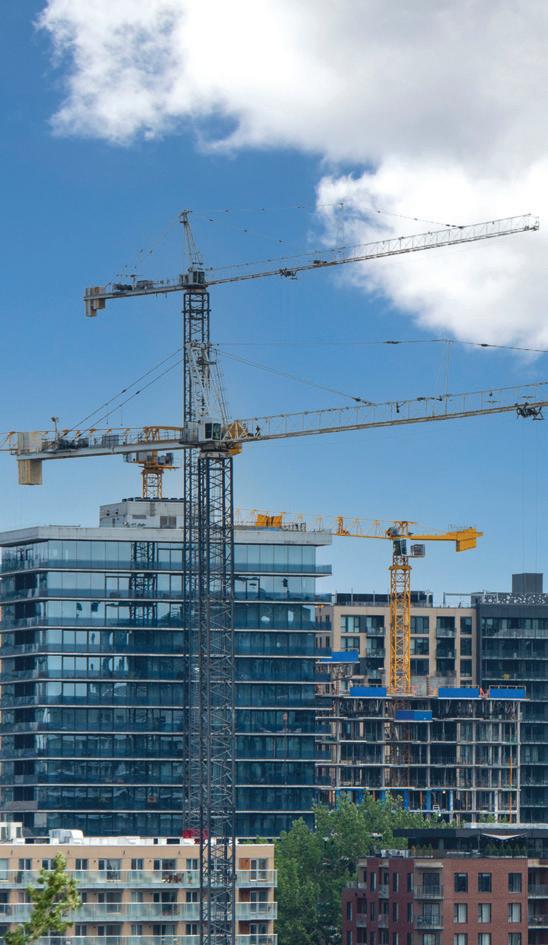








Procore is proud to sponsor On-Site Magazine’s 2023 Canadian Construction Forecast, our industry’s go-to resource on what construction leaders are watching for in the upcoming year.

As a leading provider of construction management software, we are aware and mindful of the challenges owners, general contractors, subcontractors continue to face since the last few years. With issues like increasing material costs, a fragmented and unpredictable supply chain, inflationary and interest rate pressure, disconnected teams, project productivity, thinning profit margins, continuing safety concerns, and a labour shortage—now is the time for the construction industry to embrace platform technology in order to do more with less.
It would be unrealistic to expect the industry to be able to continue its rapid growth without innovating operationally and looking at ways to boost productivity. There has never been a better time to embrace change and digitally connect your field and office teams. Ongoing innovation will enable the industry to keep pace with increasing complexity and ensure performance.
It’s not too late to start the journey towards a digital transformation of your business. As industry leaders you care about preserving margins, boosting profitability, and reducing risk in all of its forms. Procore is your partner on this journey.
We can use this report to help us identify specific market signals, and build agile and enduring businesses that can effectively weather whatever challenges 2023 has in store for us.
Sincerely, Jas Saraw Vice-President, Canada Procore Technologies

Let’s get to work!
Despite the mix of rising inflation and lending rates, as 2023 approaches few companies are finding the time to slow down.
As contracting firms continue to adjust to ongoing supply chain and labour supply challenges, it may seem like the addition of spiking inflation, rising lending rates, and the threat of project delays and cancellations would be enough to put a bucket of ice water on the industry, but most companies seem to be moving ahead as strong backlogs of work are providing a level of resiliency that is not present in all segments of Canada’s economy.
While whispers about a slowing list of projects to bid on exist, many are viewing the slight reprieve as a blessing in disguise, especially at companies concerned about whether their available labour could be stretched further to allow them to bid on additional projects to add to their backlogs.
“I feel like the pipeline of work is there between public infrastructure, P3 and even some of the residential work,” said Jas Saraw, vice-president, Canada, at Procore. “I think that’s there’s an argument to be made that we’re going into possibly a very good year in 2023.”
Even if recession hits as some are predicting, he says there is a decent likelihood that the ICI and infrastructure segments would be spared the worst, going into a lower level of growth rather than a contraction. Confidence in the industry’s resiliency varies, however.
“We have seen a bearish outlook from the general contractors that I have spoken with,” said Giovanni Cautillo, president of the Ontario General Contractors Association (OGCA), although he was still cautious about looking too far ahead. “There is a reduction in the number of tenders being issued, and that is a definite red flag for ICI construction that should not be ignored.”
Of course, even in light of red flags, there continues to be interest in his province for new institutional and transit infrastructure.
“In the ICI realm, infrastructure projects are needed, and must continue, although increases in interest rates may stave off subsequent phases of building out a project in lieu of a more favourable economic climate,” he explained.
B.C.’s ICI sector is also facing its challenges.
“I think even though the ICI industry
in British Columbia seems very busy right now, that elevated demand is hiding a significant amount of underlying vulnerability,” said Chris Atchison, president of the B.C. Construction Association (BCCA).


He explained that the post-COVID expansion of work-from-home staff has hit the commercial segment hard. As people are far more willing to work from home, or with some sort of hybrid model, the demand for new office space has suffered.
“There’s not this demand for more commercial construction, and in amongst that we’ve got equipment shortages, material price volatility, the ongoing skilled worker shortages.”
He expressed concern that the combination of material shortages, skilled worker shortages and slowing demand could combine to drive the cost of construction even higher. Despite those worries, there is still a buzz of activity.
“There are so many projects that have secured financing both in the private and public sector,” said Atchison as he pointed out hospital projects, Kitimat’s liquid natural gas terminal, and the rebuilding of roads that became a priority after last year’s flooding. All are strong drivers of
Amid a stack of challenges, 2023 looks likely to illustrate the resiliency of Canada’s construction sector.
activity for the B.C. construction sector. “There will still be economic activity. It’s not going to be a collapse or a shutdown.”

“One thing we’ve seen over the long term is an investment from Canadian governments in public infrastructure, and that seems to be continuing,” added Saraw. “Whether it’s four or five new hospitals getting built in B.C. right now, and some in the Maritimes, and a lot of P3 works being put in the ground – we’ve got subway expansion happening in Ontario – there’s a lot of infrastructure projects that are allowing a lot of contractors to dive into work.”
Once started, major projects like the transit projects in Ontario and Quebec and the building of new highways like Ontario’s Highway 413, are highly unlikely to stop, despite the risk of cost inflation.
“We’ve been in an absolute bubble for the last 10 to 15 years – a real bull market – and I think we’re seeing the benefit of that in terms of the infrastructure we’re building and the projects that we have in the ground, and the reality is that it is difficult to stop those jobs,” explained Saraw.
Labour and supply chain challenges continue to be the major impediments to taking on new work, however.
“When we talk to our specialty contractor and contractor customers, a lot of a lot of them are turning down work right now,” he said, explaining that the labour shortage is making it difficult for these companies to take on more work. And that’s a concern in many parts of the country.
“The construction industry has been trying to attract new entrants into all of the possible construction roles. Existing workers are either retiring or departing from the industry and the workforce required greatly exceeds those entering the field,” stated Cautillo. “This discrepancy translates into a limit on the number of projects any one general contractor can accept due to a physical lack of people to perform said project.”
“There is a significant labour shortage in the industry,” said Saraw. “And that’s not something that is going to get solved anytime soon.”
Training of a next generation of trades professionals is the ideal solution, but it is also a solution that needs a long runway, explained Cautillo. “Government-led campaigns targeting students are a step in the right direction, and may yield results in five to 10 years, but they do not solve our
immediate need,” he said
A shorter-term option is immigration, but it too also has limitations and challenges as immigration policies may not align with the sector’s need for specific skilled trades, and training or retraining is often still needed.
“The OGCA is working with other associations, including the Canadian Construction Association, on reducing the barriers for immigration, especially for skilled workers,” he added.
An additional concept of doing more with less and finding efficiencies in processes is a complementary option that may have a more immediate impact on a company’s ability to tackle additional projects, however.
“In partnership with Dodge Data, Procore published a survey found that 20 per cent of specialty contractors’ time was spent on low-productivity tasks,” explained Saraw. “That’s where a platform like Procore comes in, where we can drive the level of efficiency to take a task that might be hours down to minutes… It allows you to take on more work.”
Creative solutions are also helping contractors manage the uncertainty of the supply chain as well. New contracts with price escalation clauses are becoming more common, as are more collaborative project procurement models. To that end, organizations like the OGCA have crafted escalation clauses that member companies can use to reduce overall exposure in contracts.
“We recommend that contractors ensure that contracts allow for such volatility in the supply chain. Moreover, contractors need to be keeping complete and detailed records of all interactions and communications,” advised Cautillo.
Becoming more efficient, finding new workers and finding ways to manage the unexpected are all key strategies that may help contractors navigate what could be an interesting year ahead, and fewer project commitments may help return balance to material pricing and availability.
“The expectation for the Canadian market over the course of the next nine to 12 months is hopefully a minor blip, and perhaps an opportunity for a bit of a reset,” said Saraw.
By the middle of 2022, the province was tracking a list of more than 350 major projects worth $135 billion that included roadworks, condominium buildings, hospitals and schools – most with completion dates between 2023 and 2025.

Key projects include the widening of Highway 1 in Langley, the construction of the Gateway Building at UBC in Vancouver, the replacement of Stuart Lake Hospital in Fort St. James, a new hospital and cancer centre in Surrey, and a new transit exchange with 12 bus bays to service communities on Vancouver’s north shore.
The first nine months of 2022 saw more than $4.6 billion of permits issued by the city of Calgary alone. In Edmonton, the city’s four-year budget plan includes $2.2 billion to maintain existing infrastructure, and another $4.4 billion for such approved construction projects as LRT expansion projects and new recreation centres.
In addition to oilfield and pipeline projects, the province also has a large number of road projects, infrastructure work, institutional builds and commercial projects on the docket for 2023, including $133 million in provincial money to expand and build new operating rooms over the next three years.

In its 2022-23 budget, Saskatchewan’s provincial government posted a target to invest $30 billion in infrastructure by
2030. Included in that figure is roughly $1.6 billion in transportation infrastructure over the next four years, with $479.5 million landing in the 2022-23 budget. The province has upgraded more than 1,000 km this year, and 3,500 over the past three years, putting the province about a third of the way through that ongoing plan.
Flood mitigation and roads are key focal points for Manitoba. The provincial transportation and infrastructure ministries have a three-year capital plan that includes upgrading Winnipeg’s Perimeter Highway to freeway standards, expansion of the grid of highways that can support heavy commercial loading, and improved flood protection for Lake Manitoba and Lake St. Martin. Construction is also expected to soon start on a $64.4 million planned renovation and expansion at Boundary Trails Health Centre in Winkler, one of several healthcare projects in an $812 million planned spend across the province.
From the Ontario Line subway to new highways and LRT systems and, of course the Gordie Howe Bridge, Ontario is the land of the multi-billion project. The provincial government has a 10-year $61.6 billion plan to improve public transit, and recently broke ground for the Ontario Line, which will provide rapid transit between the exhibition grounds near Ontario Place and the Ontario Science Centre by 2030. The province also has several hospital projects in
various stages, including the Gilgan Family Queensway Health Centre in Etobicoke and a new Mississauga hospital. Also on the docket are Highway 413, a $36 million Confederation GO Station in Hamilton, a $540 million biomanufacturing facility in Hamilton, an $800 million laboratory research centre in Deep River, northwest of Ottawa, and Nokia Canada’s $340 million plan to build a research and development campus in Kanata.
Along with Montreal’s Metropolitan Express Network light rail system that should open its first station in 2023 (which has a stated completion target of 2024), the province has numerous major projects that will keep construction firms busy next year. Jacques-Bizard bridge is set to be replaced. The Centre Hospitalier Universitaire de Quebec (CHUQ) is redeveloping Enfant-Jesus hospital. And major roadwork is underway, including the widening of Highway Henri-IV (Route 573).
Rebuilding efforts after the floods and hurricanes over the past two storm seasons will continue in Canada’s Atlantic provinces in 2023, but there are also other projects in the works, including the South Shore Regional Hospital Redevelopment Project in Bridgewater, N.S., $1.13 billion over the next three years in New Brunswick for transportation projects, and a new $330 million Adult Mental Health and Addictions Facility in St. John’s.
© MRTIMMI / ADOBE STOCK


1.Recession or ramp up?
The case for investing in infrastructure makes economic and social sense. As Canada and other countries seek to curb inflation, there will be more onus on governments to continue to invest. There are new highway and light rail developments, climate resilience retrofits, and vital maintenance projects underway as part of the nation’s growth plan. Risk can fluctuate in every construction project, but private investors are especially vulnerable in today’s market of escalating prices, supply chain disruptions, rising interest rates on loans, and challenges securing workers.
The federal government’s 2021 invitation to consult on Canada’s National Infrastructure Assessment was highly welcomed by the Canadian Construction Association (CCA) and our industry, but what happened?

We jumped on the opportunity to provide a national vision for infrastructure resilience, recommending a strategy that would identify needs and priorities based on independent expert advice.The consultations appeared to be a step in the right direction yet little concrete action has taken place since.
Canada’s reputation as a trading nation is in steep decline. In just 10 years, the country has fallen from 10th position to 32nd in terms of its trade transportation infrastructure. This is just below Azerbaijan and ahead of Turkey and Saudi Arabia. We need a massive scale-up in our country’s trade infrastructure.
The 2022 Federal Budget made some modest investments to improve supply chain infrastructure and support the existing National Trade Corridors Fund, but more is needed for Canada to remain globally competitive, expand into new and emerging markets, attract investors, and boost employment.
The industry has recommended a path forward, identifying and investing in Canada’s key trade gateways and corridors across the country that will link resources to industry, people to jobs, and products to market. It’s time to show that Canada can deliver the goods through a strategic trade infrastructure program.
It’s no secret that Canada is facing its most severe labour shortage in over 50 years. The situation is especially
acute for the construction sector and its 81,000 open yet unfilled jobs. Retirements and recruitment challenges will be a heavy blow to Canada’ future economic growth if steps aren’t taken to rebuild Canada’s workforce now.
Training takes time and we need workers now. Immigration and temporary foreign labour can help alleviate the choke points, but to get there we need to modernize Canada’s immigration policy. While the federal government has pledged to increase immigration, it’s not just a numbers game. The current federal immigration point system does not favour the trades. Many newcomers cannot even find work in their field of expertise. We need to put their skills and experience to work and expedite the recognition of their training and credentials.
After years of relegating skilled trades to a career of last resort, governments and educational institutions are reinvested in promoting these careers.

The projected demand for skilled workers is far outweighing the number of people who are choosing to pursue a career in the trades. A report by the Canadian Apprenticeship Forum found that 75,000 new apprentices will need to be hired per year over the next five years to meet the
© TREECHA / ADOBE STOCKWhere is the action on the federal promise to collaborate?
next 12 months unfold.PHOTO:
demand for skilled journeypersons in Red Seal trades.
Smart investments are now being made to support businesses in offering apprenticeship training to Canadians from all backgrounds. The Canadian Apprenticeship Service is one such program that CCA is promoting, and it offers financial incentives to small and medium-sized employers who hire and train new first-year apprentices in 39 Red Seal trades. Schools and local businesses are also doing a better job at exposing youth to potential career paths.
This new appreciation for skilled trades combined with an infusion of new Canadians will help propel diversity and inclusivity forward, with greater representation from women, new Canadians, Indigenous and other equity-seeking groups.
Today’s financial climate and supply chain issues are forcing developers to rethink their project plans. Rising interest rates, taxes and debt financing are particular concerns, delaying or slowing down projects. Availability of bonding and insurance may also tighten.
Contractors will continue to face unpredictability in supply availability and costing. The war in Ukraine, the “Buy U.S.” initiative, massive infrastructure investment south of the border, and the
potential for disruptions from climate related events all stand to impact the supply chain. It will be important to influence and monitor policies to secure a more resilient and green supply chain.
step
Over 120 countries, including Canada, are setting targets to limit emissions and decarbonize economies. With buildings representing almost 40 per cent of global greenhouse gas emissions, not to mention the environmental impact of heavy industry, Canada’s Green Building Strategy is looking to the Canadian construction sector to make a real impact on annual carbon dioxide emissions.
This is perhaps a once in a generation opportunity to make a quantum leap in building green. It requires mobilization of both private and public sectors, and all levels of government. Developing a buy clean policy, incenting businesses, mandating change through building code amendments, and deliberately including climate resilience in the project scope at the tender process should be considered. Education and training are also critical pieces of the puzzle, including access to better data, technologies, tools and standards as well as supporting workforce training programs geared towards low-carbon construction.
COVID-19 significantly disrupted both employer and employee beliefs that the office is the centre of corporate culture and connectedness. Even before the pandemic, the construction industry began adopting digital tools and apps for the job site. With many firms only recently establishing rules of in-office presence, there will continue to be some tension between employers and employees as we navigate new ways of working together.
As self-checkouts replace traditional cashiers in grocery stores and pharmacies as a response to a lack of workforce, the construction industry will also be turning its attention to increased use of technology. With 81,000 job openings, and despite significant effort to recruit and retain a workforce, the business case for automation is strengthening.
Some companies are looking at robotics and new technologies, like exoskeletons and drones, as tools to increase productivity, growth and safety. As more technology is adopted in the industry, new types of jobs will be added within the sector – attracting new talent that wish to use cutting-edge technologies in the industry.

The value of involving contractors earlier in the project is gaining steam. Owners are recognizing that early engagement and collaboration can produce a more informed project plan, resulting in better pricing for risk and potentially identifying more efficient and effective ways of delivering projects.
This is a step in the right direction to updating Canada’s current procurement system to one that supports fair competition, long-term value and sustainability over low-cost bid, and shared risk. Too often contractors take on the majority risk of project costs and delays due to the shortage of workers, materials and supply chain disruptions.